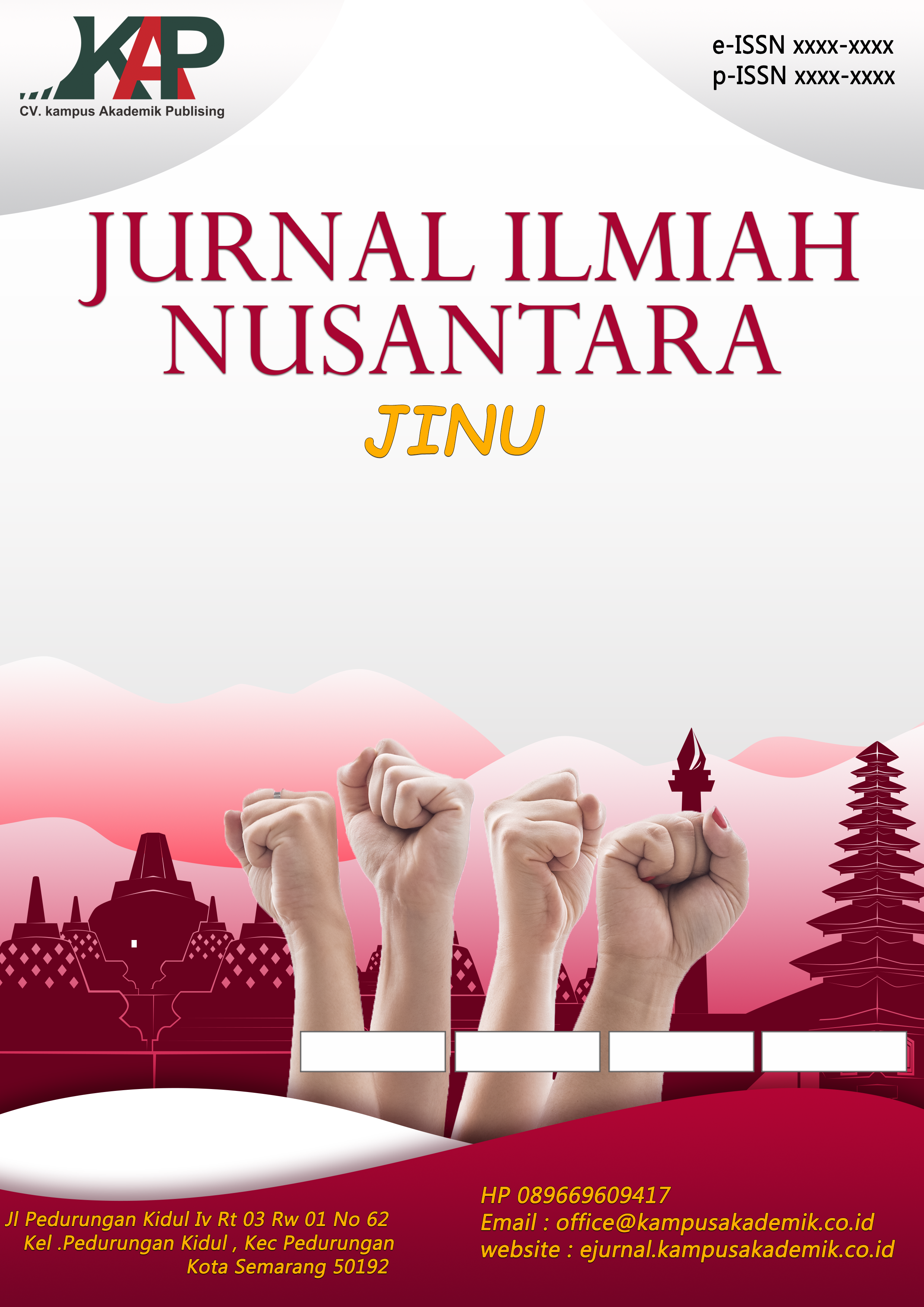Fenomena Cyber-religion pada Remaja Di Desa Kedungpari Kecamatan Mojowarno Kabupaten Jombang
DOI:
https://doi.org/10.61722/jinu.v2i5.5648Keywords:
Cyber-religion, Adolescents, Social Media, Religious Understanding, Digital Da’wah, Digital Literacy, Kedungpari Village, Qualitative ApproachAbstract
This study examines the phenomenon of cyber-religion and its impact on the understanding and practice of religious values among adolescents in Dusun Jabaran, Desa Kedungpari, Mojowarno District, Jombang Regency. As a rural area increasingly affected by digital technology, the region shows a noticeable shift in religious behavior, particularly among youth who now prefer to access religious content through social media platforms. This research employs a qualitative approach with a descriptive method. Data were collected through observation, in-depth interviews with 8 adolescents, and documentation of online religious activities. The findings reveal that adolescents actively use platforms such as YouTube, TikTok, WhatsApp, and Instagram to access short sermons, prayers, and Islamic quotes. Although they show interest in digital religious content, their primary motivation for using social media remains centered on entertainment. The lack of digital literacy and minimal guidance from parents or religious figures has led to a shallow and fragmented understanding of religion. Furthermore, their participation in traditional religious activities has declined, replaced by passive engagement in online content. Nevertheless, the emergence of online religious study groups initiated by local mosque youth illustrates the positive potential of digital media as a tool for dakwah.
References
“Agama - Wikipedia Bahasa Indonesia, Ensiklopedia Bebas,” n.d. https://id.wikipedia.org/wiki/Agama.
Asiva Noor Rachmayani. METODOLOGI PENELITIAN KUALITATIF, 2015.
Beno, J, A.P Silen, and M Yanti. “FENOMENA BELAJAR AGAMA GENERASI MILLENIALS: STUDI KASUS PADA MAHASISWA FAKULTAS SAINS DI PERGURUAN TINGGI KEAGAMAAN ISLAM WILAYAH SUMATRA UTARA.” Braz Dent J. 33, no. 1 (2022): 1–12.
Best, European, and Practice Guidelines. “E. Best, P. Guldelines Pengaruh Cyber Religion” 1, no. 1 (2011): 1–10.
Bheka, T, and E Tarihoran. “Membangun Komunitas Iman Melalui Media Sosial Dengan Menggunakan Platfrom Yang Menarik.” Jurnal Magistra 2, no. 2 (2024). https://ejurnal.stpdianmandala.ac.id/index.php/magistra/article/view/101%0Ahttps://ejurnal.stpdianmandala.ac.id/index.php/magistra/article/download/101/125.
Cahyati, N D. ANALISIS KONTEN DAKWAH DALAM PODCAST (Studi Kasus Di Kantor Kementerian Agama Kota Madiun), 2023. http://etheses.iainponorogo.ac.id/26452/1/skripsi nina.pdf.
Dawson, Lorne L., and Douglas E. Cowan. Religion Online: Finding Faith on the Internet. Religion Online: Finding Faith on the Internet, 2004. https://doi.org/10.4324/9780203497609.
Dwi Andriani, Astri. “Cyberreligion: Peran Kecerdasan Buatan Sebagai Media Komunikasi Pembelajaran Pendidikan Agama … Cyberreligion: The Role of Artificial Intelligence as a Communication Medium for Religious Education Learning in the Digital Era.” TARBAWY: Indonesian Journal of Islamic Education 10, no. 2 (2023): 145. https://ejournal.upi.edu/index.php/tarbawy/index.
Fajarina, Agus, Ballian Firmansyah, and Yustiawati Siregar. “Fenomena Adiksi Penggunaan Media Sosial Youtube Pada Remaja Usia 15-19 Tahun (Studi Fenomenologi Di RW 18.” Dasana Indah Tangerang) Forum Ilmiah 18 (2021): 41. www.apjii.or.id.
Fiantika, Feny, Mohammad Wasil, Sri Jumiyati, Leli Hpmesti, and Sri Wahyuni. Metodologi Penelitian Kualitatif. Yuliatri N. Padang: PT. GLOBAL EKSEKUTIF TEKNOLOGI, 2022. https://scholar.google.com/citations?user=O-B3eJYAAAAJ&hl=en.
Ginanjarsari, Razhela Lintang. “Gambaran Perilaku Remaja Putri Mengenai Upaya Penanganan Dismenore Di Kelas XI MA Ali Maksum Putri Bantul Yogyakarta Tahun 2019.” Politeknik Kesehatan Kementerian Kesehatan 22 (2019): 1–7. http://eprints.unwahas.ac.id/2196/.
Habibi, Malik. “Cyber Religion Dan Real Religion Di Tengah Masyarakat Digital.” Komunika 4, no. 1 (2021): 63–78.
Hakim, Siti Nurina, Aliffatullah Alyu Raj, and Dara Febrian Chita Prastiwi. “Remaja Dan Internet.” Prosiding SEMNAS Penguatan Individu Di Era Revolusi Informasi, no. 2008 (2016): 311–19. https://publikasiilmiah.ums.ac.id/bitstream/handle/11617/9290/Siti Nurina Hakim.pdf?sequence=1&isAllowed=y.
Haridakis, Paul, and Zachary Humphries. “Uses and Gratifications.” An Integrated Approach to Communication Theory and Research, Third Edition, 2019, 139–53. https://doi.org/10.4324/9780203710753-13.
Hidayat, Addib Wahyu, Ahmad Najeri, Nadia Mei Safitri, Noorhikmah Maulina, and Nor Azizah. “Pemanfaatan Media Sosial Sebagai Sarana Dakwah Untuk Mengantisipasi Kerawanan Sosial Generasi Z.” Jurnal Religion: Jurnal Agama, Sosial, Dan Budaya 1, no. 6 (2022): 1–10. https://maryamsejahtera.com/index.php/Religion/article/view/36.
Kajian, Prosiding, Integrasi Ilmu, Society Kiiies, Mansur Mustakim, Hamka Hamka, and Fatimah Saguni. “Konsep Pendidikan Islam Dan Masyarakat Di Era Digital” 0 (2024): 146–50.
Kusainun, Noven. “ANALISIS STANDAR PENILAIAN PENDIDIKAN DI INDONESIA Noven Kusainun.” JUrnal Pendidikan 5, no. 1 (2020): 1–7.
Moleong. “Validasi Dan Reliabilitasi Data,” 2014, 26–55.
Mubarok, Akbar Rizquni, and Sunarto Sunarto. “Moderasi Beragama Di Era Digital: Tantangan Dan Peluang.” Journal of Islamic Communication Studies (JICoS) 2, no. 1 (2024): 1–11. https://doi.org/10.15642/jicos.2024.2.1.1-11.
Nurlela, Oleh Andi, Atma Ras, and Musrayani Usman. “Dampak Media Sosial Terhadap Pembentukan Identitas Sosial Anak Di Era Digital” 6, no. 2 (2024): 185–94.
Puspianto, Alim. “Strategi Dakwah Masyarakat Kota.” An-Nida’: Jurnal Prodi Komunikasi Dan Penyiaran Islam IX, no. 1 (2020): 42–64. http://e-jurnal.stail.ac.id/index.php/annida/article/download/217/135.
Safitri, Ririh Megah. “Depersonalisasi Dan Simbolisasi Agama Dalam Ruang Dakwah Digital.” Islamic Management and Empowerment Journal 5, no. 2 (2023): 199–212. https://doi.org/10.18326/imej.v5i2.199-212.
SARAH, RAHMA. “EFEKTIVITAS PEMBELAJARAN PENDIDIKAN AGAMA ISLAM SECARA DARING DI MASA PANDEMI COVID-19 DI SMKN 1 AL-MUBAREY INGIN JAYA ACEH BESAR,” 2016, 1–23.
Siregar, Asma Sari, and Maulana Andi Surya. “Analisis Use And Gratification Dalam Menentukan Strategi Dakwah Virtual.” An Nadwah XXVIII, no. 2 (2022): 1–12. http://jurnal.uinsu.ac.id/index.php/nadwah/article/view/14203.
Wijaya, Akhmad Pandhu, Agung Nugroho, Mahfudlah Fajrie, M. Nashrul Haqqi, Puja Pratama, Achmad Umar Setyadi, Virasti Setiani, and Dwi Fania. “Praktik Cyber Religion Remaja Perkotaan.” Jurnal Komunikasi Nusantara 5, no. 2 (2023): 208–17.
Winman, Dorothea Febe, and Natalia Olivia Kusuma Dewi Lahamendu. “Cyberspace Dan Unggahan Status Religius Di Media Sosial.” PUTE WAYA: Sociology of Religion Journal 2, no. 1 (2021): 44–62.
Yan Fikri Hendrawan, Mohammad, Subktiningsih, and Arifiyanto Hadinegoro. “Analisis Bukti Digital Pada Discord Browser Menggunakan Teknik Live Forensic Dengan Metode NIST SP 800-86.” Jurnal Infomedia: Teknik Informatika, Multimedia Dan Jaringan 8, no. 2 (2023): 94–99.
James E. Marcia, “Ego‑Identity Status,” Journal of Personality and Social Psychology (1966) serta Erikson (1968) dalam Handbook of Adolescent Digital Media Use (Cambridge, 2024
Downloads
Published
Issue
Section
License
Copyright (c) 2025 JURNAL ILMIAH NUSANTARA

This work is licensed under a Creative Commons Attribution-ShareAlike 4.0 International License.













